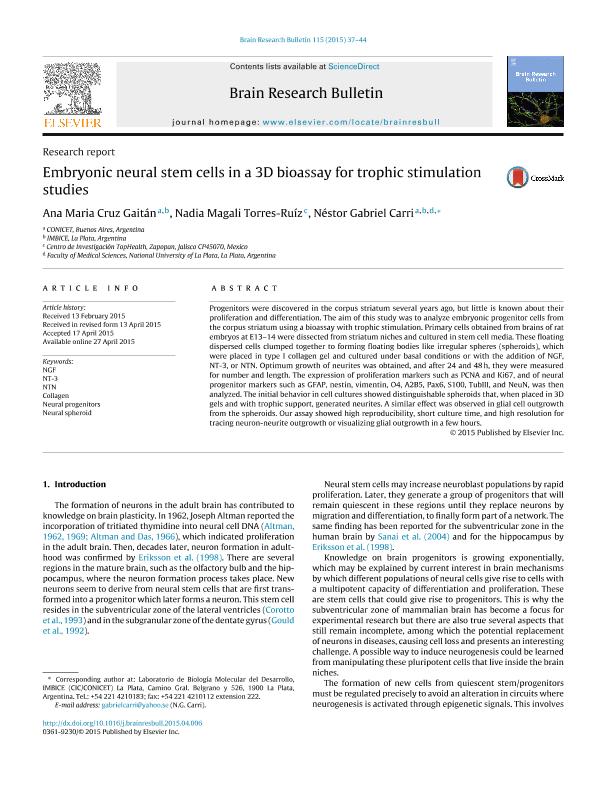Artículo
Embryonic neural stem cells in a 3D bioassay for trophic stimulation studies
Fecha de publicación:
06/2015
Editorial:
Pergamon-Elsevier Science Ltd
Revista:
Brain Research Bulletin
ISSN:
0361-9230
Idioma:
Inglés
Tipo de recurso:
Artículo publicado
Clasificación temática:
Resumen
Progenitors were discovered in the corpus striatum several years ago, but little is known about their proliferation and differentiation. The aim of this study was to analyze embryonic progenitor cells from the corpus striatum using a bioassay with trophic stimulation. Primary cells obtained from brains of rat embryos at E13-14 were dissected from striatum niches and cultured in stem cell media. These floating dispersed cells clumped together to forming floating bodies like irregular spheres (spheroids), which were placed in type I collagen gel and cultured under basal conditions or with the addition of NGF, NT-3, or NTN. Optimum growth of neurites was obtained, and after 24 and 48. h, they were measured for number and length. The expression of proliferation markers such as PCNA and Ki67, and of neural progenitor markers such as GFAP, nestin, vimentin, O4, A2B5, Pax6, S100, TubIII, and NeuN, was then analyzed. The initial behavior in cell cultures showed distinguishable spheroids that, when placed in 3D gels and with trophic support, generated neurites. A similar effect was observed in glial cell outgrowth from the spheroids. Our assay showed high reproducibility, short culture time, and high resolution for tracing neuron-neurite outgrowth or visualizing glial outgrowth in a few hours.
Palabras clave:
Collagen
,
Neural Progenitors
,
Neural Spheroid
,
Ngf
,
Nt-3
,
Ntn
Archivos asociados
Licencia
Identificadores
Colecciones
Articulos(IMBICE)
Articulos de INST.MULTIDISCIPL.DE BIOLOGIA CELULAR (I)
Articulos de INST.MULTIDISCIPL.DE BIOLOGIA CELULAR (I)
Citación
Cruz Gaitán, Ana María; Torres Ruíz, Nadia Magali; Carri, Nestor Gabriel; Embryonic neural stem cells in a 3D bioassay for trophic stimulation studies; Pergamon-Elsevier Science Ltd; Brain Research Bulletin; 115; 6-2015; 37-44
Compartir
Altmétricas




